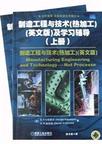制造工程与技术(上下册)
出版时间:2004-1-1 出版社:机械工业出版社 作者:(美)S卡尔帕基安SR施密德
Tag标签:无
内容概要
时代教育·高校双语优秀教材。
作者简介
作者:(美国)S.卡尔帕基安(Serope Kalpakjian) (美国)S.R.施密德(Steven R.Schmid)
书籍目录
上册:制造工程与技术(热加工)(英文版)下册:制造工程与技术(热加工)学习辅导/全燕鸣主编
章节摘录
版权页: 插图: 14.7 DIE MATERIALS AND LUBRICATION Among important aspects of forging (as well as of other manufacturing processes discussed in Part Ⅲ) are die materials and lubrication. Die Materials.Most forging operations, particularly forlarge parts, are carried out at elevated temperatures. General requirements for die materials therefore are (a) strength and toughness at elevated temperatures, (b) hardenability and ability to harden uniformly, (c) resistance to mechanical and thermal shock, and (d) wear resistance, particularly resistanceto abrasive wear, because of the presence of scale in hot forging. Selection of proper die materials depends on such factors as the die size, the composition and the properties of the workpiece, the complexity of the shape, the forging temperature, the type of forging operation, the cost of the die materials, and the number of forgings required. Heat transfer from the hot workpiece to the dies (and subsequent distortion of the dies) is also an important factor. Common die materials are tool and die steels containing chromium, nickel, molybdenum, and vanadium (see Tables 5.5 and 5.6). Dies are made from die blocks, which themselves are forged from castings and then machined and finished to the desired shape and surface finish. Die failures usually result from a variety of the reasons described in Section 14.10. Die manufacturing methods are also described in that section. Lubrication.Lubricants greatly influence friction and wear; consequently, they affect the forces required (Eq.14.1) and the flow of the metal in die cavities. They can also act as a thermal barrier between the hot workpiece and the relatively cool dies, slowing the rate of cooling of the workpiece and improving metal flow. Another important role of the lubricant is to serve as a parting agent, that is, one which inhibits the forging from sticking to the dies and helps in its release from the die. A wide variety of lubricants can be used in forging. (See also Chapter 32.) For hot forging,graphite, molybdenum disulfide, and sometimes glass are used. For cold forging, mineral oils and soaps are common lubricants, applied after conversion coating of the blanks (Section 32.12). In hot forging, the lubricant is usually applied directly to the dies; in cold forging, it is applied to the workpiece. The method of application and the uniformity of the lubricant's thickness on the blank are important to product quality.
编辑推荐
《时代教育•高校双语优秀教材:制造工程与技术(热加工)及学习辅导(英文版)(套装共2册)》叙述严谨、逻辑清晰、内容适度易懂,具有很高的实用价值。可作为机械工程类的本、专科学生学习英文原版教材的辅导,也可随原版教材一起作为工程技术人员的参考资料及涉外企业员工的培训教材。
图书封面
图书标签Tags
无
评论、评分、阅读与下载
用户评论 (总计1条)
- 是正版的,质量不错……而且很便宜,
